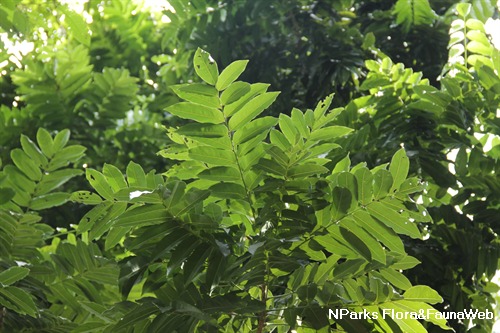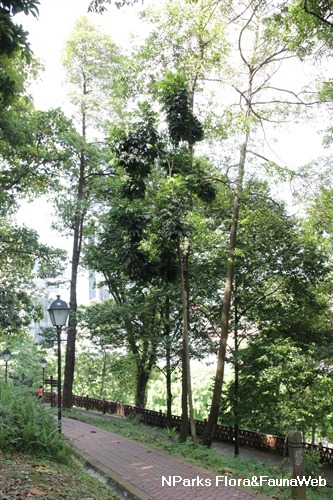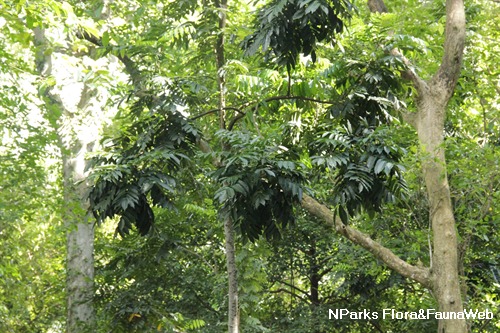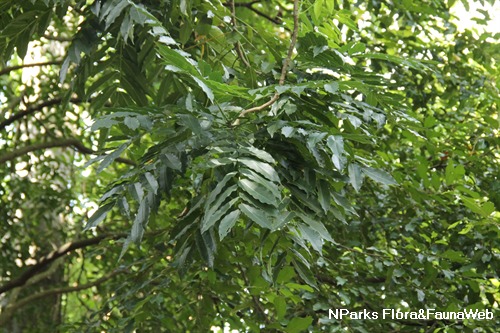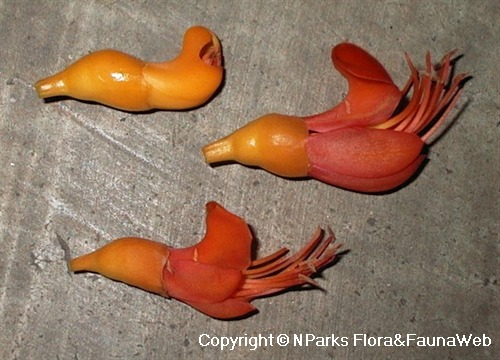
Back
Castanospermum australe A.Cunn. ex Mudie
| Family Name: | Fabaceae (Leguminosae) |
| Common Name: | Moreton Bay Chestnut, Black Bean, Australian Chestnut |
Name
Classifications and Characteristics
| Plant Growth Form | Tree |
|---|---|
| Mode of Nutrition | Autotrophic |
Biogeography
| Native Distribution | Tropical Australia, New Caledonia, Vanuatu |
|---|---|
| Native Habitat | Terrestrial |
| Preferred Climate Zone | Tropical, Sub-Tropical / Monsoonal |
Description and Ethnobotany
| Growth Form | Large slow-growing tree, usually reaches up to 8 - 20 m, and sometimes 40 m in its natural habitat. |
|---|---|
| Crown | Has a rounded and dense canopy, with a spread of about 5 - 8 m wide. |
| Trunk | Bark is grey to brown and surface has small raised spots, girth size can reach up to 1.2 m wide. |
| Foliage | Dark green leaves, imparipinnate and alternate arrangement, measuring about 20 - 35 cm long, each leaf consist of about 8 - 17 oval leaflets in alternate arrangement, each leaflet about 8 - 17 cm long and 3 - 6 cm wide. |
| Flowers | Orange-red bell-shaped flowers borne on a raceme inflorescence up to 15 cm long, each flower is about 4 - 5 cm long, calyx is yellow and bell-shaped and 5-lobed, 8 - 10 yellow stamens present, ovary on a stalk about 1.5 - 2 cm long, style about 1 - 2 cm long. |
| Fruit | Fruit is a cylindrical pod, large and woody, measuring about 15 - 25 cm long and 4 - 5 cm wide, contains 3 - 5 brown seeds. |
| Others - Plant Morphology | Leaves and seeds are toxic to livestock. |
| Habitat | Endemic to coastal rainforests and beaches in Australia, can also be found in dry riverine rainforests. |
| Etymology | Genus Castanospermum is from Greek words "kastanon and sperma" (sperma meaning seed) and refers to the shape of the seed. Species australe means from the South. |
| Ethnobotanical Uses | Edible Plant Parts : Edible Seeds Medicinal: Used to treat post-prandial hyperglycaemia in diabetic patients. Timber & Products: Wood can used as fencing material and as a source of fuel. Agriculture - Forestry: Can be planted to protect against erosion on riverbanks and catchment areas. |
Landscaping Features
| Desirable Plant Features | Ornamental Flowers, Ornamental Fruits |
|---|---|
| Landscape Uses | Parks & Gardens |
| Usage Hazard - Cons | Aggressive Roots |
Fauna, Pollination and Dispersal
| Fauna Pollination Dispersal Associated Fauna | Bird-Attracting, Butterfly-Attracting, Bat Food |
|---|---|
| Pollination Method(s) | Biotic (Fauna) |
Plant Care and Propagation
| Light Preference | Full Sun |
|---|---|
| Water Preference | Moderate Water |
| Plant Growth Rate | Moderate |
| Rootzone Tolerance | Moist Soils, Well-Drained Soils |
| Propagation Method | Seed |
Foliar
| Mature Foliage Colour(s) | Green |
|---|---|
| Leaf Area Index (LAI) for Green Plot Ratio | 3.0 (Tree - Intermediate Canopy) |
Floral (Angiosperm)
| Flower Colour(s) | Orange, Red |
|---|---|
| Flower Grouping | Cluster / Inflorescence |
| Individual Flower Shape | Campaulate / Bell-shaped |
| Inflorescence Type | Raceme |
Fruit, Seed and Spore
| Fruit Classification | Simple Fruit |
|---|
Image Repository
Others
| Master ID | 1498 |
|---|---|
| Species ID | 2791 |
| Flora Disclaimer | The information in this website has been compiled from reliable sources, such as reference works on medicinal plants. It is not a substitute for medical advice or treatment and NParks does not purport to provide any medical advice. Readers should always consult his/her physician before using or consuming a plant for medicinal purposes. |


